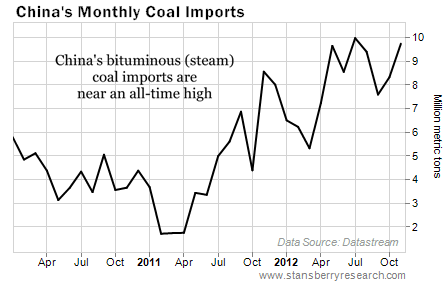 It’s a confirmed commodity boom in China.
It’s a confirmed commodity boom in China.
Over the past couple weeks, I’ve shown you how the world’s largest commodity consumer is importing record amounts of copper and driving iron ore prices well off their lows.
Because China is such an enormous part of the global market, a sustained increase in demand here can kick off a huge rally in natural resources.
[ad#Google Adsense 336×280-IA]It turns out, copper and iron ore aren’t the only resources China is hungry for… and they’re not the only trends set to pay off for early traders.
Coal is one of the market’s most hated commodities right now.
As Growth Stock Wire readers know, U.S. natural gas prices have seen a huge drop since 2008.
Prices are about half what they were in the early 2000s.
Natural gas competes with coal as a fuel for electric power. So low natural gas prices have destroyed the coal companies that mostly sell to U.S. customers.
But the story is taking a very different turn overseas.
In 2011, China burned 1.26 billion metric tons of bituminous (or steam) coal to generate over 80% of the country’s electric power supply. That’s 22% of the world’s steam coal production in 2011… all consumed in China.
China’s demand for coal is up over 14% from 2010 to 2011. And we’re watching the data from 2012 because as this chart shows, China’s demand for imported coal is nearing new highs…

China’s monthly coal imports hit 9.7 million metric tons in November. That’s just shy of the record 9.9 million metric tons set last July. And the trend since early 2011 has been up.
Major mining companies, like BHP Billiton (NYSE: BHP) and Rio Tinto (NYSE: RIO), are big coal producers in Australia. Their product goes straight to China. And they’re bound to benefit from the bigger trend here as well…
Regular readers understand China is the single most important factor in natural resource investment… It has three times the population of the United States. It could double its per-person wealth, and it would still be less than half as wealthy per person as the United States.
Like I’ve said before, a doubling of China’s per-person wealth would mean a lot more car sales… more air conditioners… more refrigerators… more cellular phones… more televisions… more dishwashers… more everything.
And it would take a mountain of commodities to build it all.
It would take lots of iron ore to make the steel that goes into car frames. It would take lots of copper to build the cooling coils in the air conditioners and refrigerators. It would take lots of coal, uranium, and natural gas to fire the power plants and generate the electricity to run the factories. It would take lots of oil and gasoline to transport people, materials, and products.
If China’s demand has a prolonged recovery, the upside here is enormous. The companies that sell the commodities to China are going to show their shareholders tremendous gains. Many commodity stocks are still well below their 2011 highs, when they earned more from higher commodity prices… and traded at higher multiples. If commodity prices continue to rise, we could easily see those companies gain 50%.
And if investors get carried away by news of China’s surging economy, we could see premium valuations… and even watch these stocks trade back up to 2007 levels, two or three times higher than today’s prices.
To most folks, these bullish gain projections sound crazy. After all, we’ve heard bearish “Chinese growth is doomed” stories for more than a year. Knocking China and its growth prospects has become the popular thing to do.
But if the crowd is wrong in 2013 – and the data is starting to show it is – betting against it and owning commodity stocks will become one of the best trades of the year.
Good investing,
Matt Badiali
[ad#stansberry-ps]
Source: The Growth Stock Wire
